英语演讲:汉字发展
汉字演变英语演讲稿范文
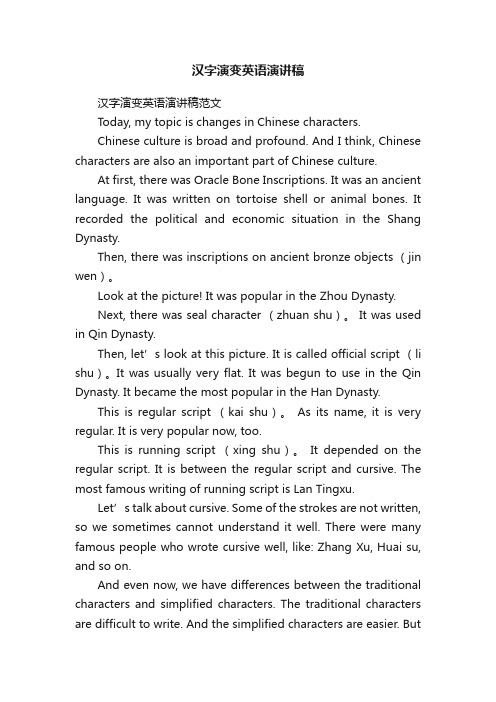
汉字演变英语演讲稿汉字演变英语演讲稿范文Today, my topic is changes in Chinese characters.Chinese culture is broad and profound. And I think, Chinese characters are also an important part of Chinese culture.At first, there was Oracle Bone Inscriptions. It was an ancient language. It was written on tortoise shell or animal bones. It recorded the political and economic situation in the Shang Dynasty.Then, there was inscriptions on ancient bronze objects (jin wen)。
Look at the picture! It was popular in the Zhou Dynasty.Next, there was seal character (zhuan shu)。
It was used in Qin Dynasty.Then, let’s look at this picture. It is called official script (li shu)。
It was usually very flat. It was begun to use in the Qin Dynasty. It became the most popular in the Han Dynasty.This is regular script (kai shu)。
As its name, it is very regular. It is very popular now, too.This is running script (xing shu)。
对汉字的介绍英文作文
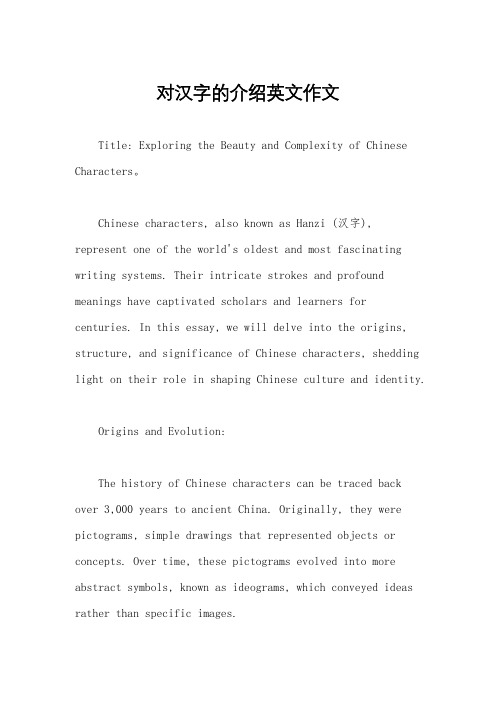
对汉字的介绍英文作文Title: Exploring the Beauty and Complexity of Chinese Characters。
Chinese characters, also known as Hanzi (汉字), represent one of the world's oldest and most fascinating writing systems. Their intricate strokes and profound meanings have captivated scholars and learners for centuries. In this essay, we will delve into the origins, structure, and significance of Chinese characters, shedding light on their role in shaping Chinese culture and identity.Origins and Evolution:The history of Chinese characters can be traced back over 3,000 years to ancient China. Originally, they were pictograms, simple drawings that represented objects or concepts. Over time, these pictograms evolved into more abstract symbols, known as ideograms, which conveyed ideas rather than specific images.One of the earliest forms of Chinese writing is found on oracle bones and bronze vessels dating back to the Shang Dynasty (1600–1046 BCE). These inscriptions provide valuable insights into the language and culture of ancient China. As civilization progressed, the script underwent numerous reforms and standardizations, leading to the establishment of the modern Chinese writing system.Structure and Composition:Chinese characters are composed of strokes, basic units of writing that are combined to form complex characters. There are eight basic types of strokes, includinghorizontal lines, vertical lines, and hooks, each of which contributes to the unique appearance of a character.Characters are typically organized into radicals, fundamental components that carry semantic or phonetic meaning. Radicals serve as building blocks for more complex characters and play a crucial role in character classification and dictionary lookup. For example, thecharacter 水(shuǐ), meaning "water," consists of the radical 氵, which indicates its semantic category.Semantic and Phonetic Elements:Chinese characters often contain both semantic and phonetic elements, allowing for a balance between meaning and pronunciation. Semantic radicals provide clues to the character's meaning, while phonetic components indicate its pronunciation. This dual structure enables Chinese speakers to infer the meaning and pronunciation of unfamiliar characters based on their existing knowledge of the language.For instance, consider the character 妈 (mā), meaning "mother." It consists of the radical 女(nǚ), meaning "woman," and the phonetic component 马(mǎ), which sounds similar to the character's pronunciation.Cultural Significance:Chinese characters are more than just a means ofcommunication; they embody the richness and diversity of Chinese culture. Through their intricate designs and nuanced meanings, characters reflect the values, beliefs, and history of the Chinese people.Moreover, Chinese characters play a vital role in preserving cultural heritage and promoting national identity. They are an integral part of traditional art forms such as calligraphy and seal carving, which require precision, discipline, and aesthetic sensitivity. By mastering these art forms, individuals can deepen their understanding of Chinese culture and express theircreativity through the written word.Challenges and Opportunities:While Chinese characters offer a window into the past and a gateway to cultural exploration, they also present challenges for learners, both native and non-native. The sheer number of characters, estimated to be over 50,000, can be daunting for beginners, requiring years of study and practice to achieve proficiency.However, advancements in technology have made learning Chinese characters more accessible than ever before. Mobile apps, online courses, and digital flashcards provide interactive tools for learners to practice writing, reading, and memorizing characters. Additionally, machine learning algorithms can assist in character recognition and language processing, facilitating communication between speakers of different languages.Conclusion:In conclusion, Chinese characters represent a unique blend of art, language, and culture, encompassing thousands of years of history and tradition. Their intricate structure, rich symbolism, and cultural significance make them a subject of fascination and admiration worldwide. By studying Chinese characters, we gain not only linguistic proficiency but also a deeper appreciation for the enduring legacy of Chinese civilization. As we continue to explore the beauty and complexity of Hanzi, we unlock new insightsinto the human capacity for creativity, expression, and communication across time and space.。
汉字文化英语演讲稿范文

汉字文化英语演讲稿范文I. English response:As a speaker of both Chinese and English, I am proud to share my thoughts on the cultural significance of Chinese characters.Chinese characters, also known as Hanzi, are not just a form of writing but a reflection of the rich history and cultural heritage of China. Each character carries its own unique meaning and pronunciation, making the Chinese language both complex and beautiful.One of the most fascinating aspects of Chinese characters is their ability to convey deep meanings and emotions. For example, the character "爱" (ài) means love, but it also contains the characters for "heart" and "friendship". This shows how love is closely connected to the heart and friendship in Chinese culture.Furthermore, Chinese characters are also a form of art. The strokes and structures of each character are carefully crafted to create a harmonious and balanced composition. This attention to detail reflects the Chinese value of balance and harmony in all aspects of life.Overall, Chinese characters play a crucial role in preserving and passing on the cultural heritage of China. They are not just symbols on a page but a living testament to the wisdom and creativity of the Chinese people.II. 中文回答:作为一个中英文双语演讲者,我很自豪地分享我对汉字文化的看法。
中国汉字文化英语演讲稿范文
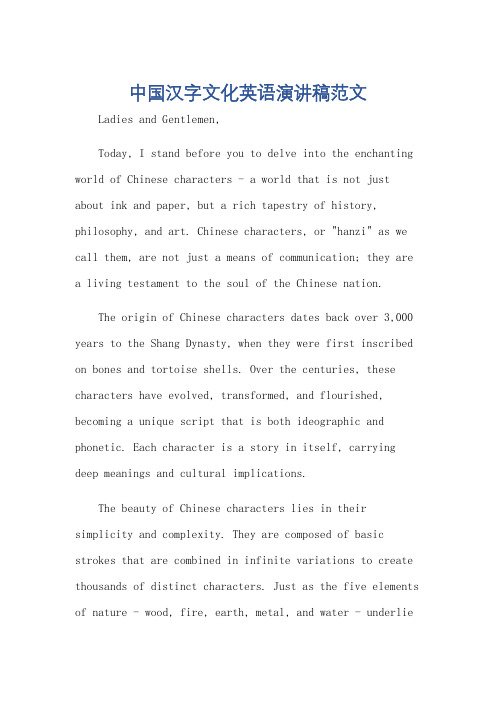
中国汉字文化英语演讲稿范文Ladies and Gentlemen,Today, I stand before you to delve into the enchanting world of Chinese characters - a world that is not just about ink and paper, but a rich tapestry of history, philosophy, and art. Chinese characters, or "hanzi" as we call them, are not just a means of communication; they are a living testament to the soul of the Chinese nation.The origin of Chinese characters dates back over 3,000 years to the Shang Dynasty, when they were first inscribed on bones and tortoise shells. Over the centuries, these characters have evolved, transformed, and flourished, becoming a unique script that is both ideographic and phonetic. Each character is a story in itself, carrying deep meanings and cultural implications.The beauty of Chinese characters lies in their simplicity and complexity. They are composed of basic strokes that are combined in infinite variations to create thousands of distinct characters. Just as the five elements of nature - wood, fire, earth, metal, and water - underliemuch of Chinese philosophy, these strokes form the building blocks of Chinese characters.The characters are not just representations of sounds and meanings; they are vehicles of wisdom and emotion. The Chinese language is highly associative, and characters often carry connotations that extend far beyond theirliteral meanings. For instance, the character for "heart"is often used to represent emotions, intentions, and even moral values.The art of calligraphy, or "shufa," further elevates the status of Chinese characters. It is not just about writing beautifully; it is about expressing one's inner world through the flow of ink on paper. Each stroke is carefully crafted, reflecting the calligrapher's thoughts, emotions, and even character. In many ways, calligraphy is a form of meditation, a way to connect with oneself and the universe.The influence of Chinese characters extends beyond the borders of China. Many languages, including Japanese, Korean, and Vietnamese, have borrowed characters from Chinese, making them a shared cultural heritage of EastAsia. This shared script has fostered cultural exchange and understanding among these nations, highlighting the powerof language in building bridges between people.In conclusion, Chinese characters are not just a meansof communication; they are a window to the rich andprofound culture of China. They are a testament to the wisdom and creativity of the Chinese people, a legacy that we continue to carry forward in our modern world. As we stand at the cusp of a new era, let us cherish this legacy, continue to learn from it, and share it with the world.Thank you.**中国汉字的魅力:理解中国文化的桥梁**女士们、先生们:今天,我站在这里,带大家深入迷人的中国汉字世界——一个不仅仅关乎墨水和纸张的世界,而是一个充满历史、哲学和艺术的丰富画卷。
汉字发展过程英语作文

汉字发展过程英语作文The Development Process of Chinese Characters。
Chinese characters have a long and rich history, with a development process that spans thousands of years. The evolution of Chinese characters can be traced back to ancient times, and their development has been influenced by various factors such as culture, language, and technology. In this essay, we will explore the development process of Chinese characters and how they have evolved over time.The earliest Chinese characters can be traced back to the Shang Dynasty, which existed over 3,000 years ago. These characters were pictographs, which means they were based on drawings of objects and symbols. For example, the character for "mountain" was originally a simple drawing of a mountain, and the character for "sun" was a circle with a dot in the middle. These pictographs were simple and easy to understand, making them an effective form of communication for the ancient Chinese people.As time passed, the Chinese characters evolved from pictographs to ideographs. Ideographs are characters that represent ideas or concepts rather than physical objects. This shift in the structure of Chinese characters allowed for a more abstract and nuanced form of communication. For example, the character for "love" is a combination of the characters for "heart" and "friend," symbolizing the concept of affection and friendship.During the Qin and Han Dynasties, the Chinese characters underwent another significant change with the standardization of the script. This standardization was led by the first emperor of China, Qin Shi Huang, who sought to unify the writing system in order to facilitate communication and governance. The result was the creation of the small seal script, which became the standard form of writing for centuries to come.In the following dynasties, the Chinese characters continued to evolve, with the introduction of new styles of calligraphy and the development of printing technology. Thecalligraphy of the Tang Dynasty, for example, is renowned for its elegance and grace, and it had a profound influence on the development of Chinese characters. Additionally, the invention of woodblock printing during the Song Dynasty allowed for the mass production of books, which further spread the use of Chinese characters throughout China and beyond.In modern times, the Chinese characters have continued to evolve with the advent of technology. The development of computers and smartphones has led to the creation of simplified and traditional Chinese characters, as well as the adoption of Pinyin, a system for transcribing Chinese characters into the Latin alphabet. These advancements have made it easier for people to learn and use Chinese characters, and they have also facilitated the global spread of the Chinese language.In conclusion, the development process of Chinese characters is a testament to the rich history and culture of China. From their origins as pictographs to their modern-day use in technology, Chinese characters haveevolved in response to the changing needs of society. As a result, they continue to be an integral part of Chinese culture and a unique and fascinating form of writing.。
中国书法英文课前演讲ppt

汉字的字体演变 The evolution of Chinese characters font
甲骨文 →金文 →小篆 →隶 →楷书 →草书 →行书
甲骨文 Oracle Bone Script
篆书 Seal script
金文 Inscriptions on bronze
隶书和楷书 Calligraphy and script
传承、创新
smriti & innovation
Chinese is the mother tongue, it’s our duty to learn and write it well though not everyone can be calligrapher
汉语是我们的母语,不一定每个 人都能成为书法家,但每个人都要 把汉语学好、把汉字写好。
At the same time, we should try our utmost to learn English well to spread Chinese to the world!
同时,我们要把英语学好,将汉 字传播到全世界!
Thank you!
Why Chinese characters can be so special?
汉字的构造 Structure • 象形 • 指事 • 会意 • 形声 • 假借
二、汉字的演变
Evolution
西安半坡仰韶文化陶器刻纹
Xi'an Banpo Yangshao culture pottery engraving
草书Cursive script
“The best cursive handwriting” 行书
王羲之 兰亭集序
古代书法作品欣赏
英语中国传统演讲稿范文
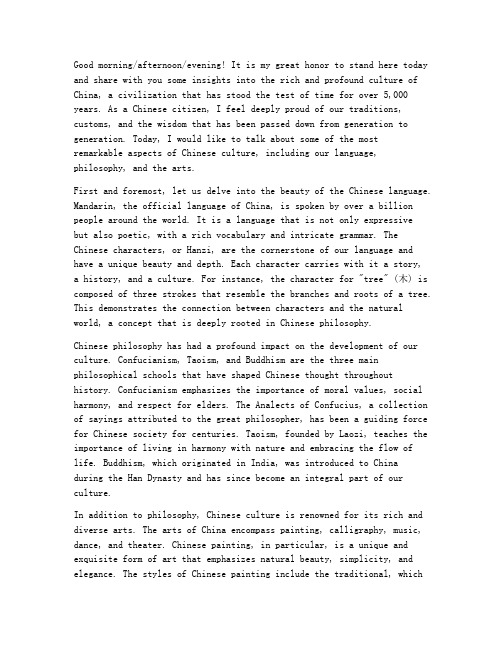
Good morning/afternoon/evening! It is my great honor to stand here today and share with you some insights into the rich and profound culture of China, a civilization that has stood the test of time for over 5,000 years. As a Chinese citizen, I feel deeply proud of our traditions, customs, and the wisdom that has been passed down from generation to generation. Today, I would like to talk about some of the most remarkable aspects of Chinese culture, including our language, philosophy, and the arts.First and foremost, let us delve into the beauty of the Chinese language. Mandarin, the official language of China, is spoken by over a billion people around the world. It is a language that is not only expressivebut also poetic, with a rich vocabulary and intricate grammar. The Chinese characters, or Hanzi, are the cornerstone of our language and have a unique beauty and depth. Each character carries with it a story,a history, and a culture. For instance, the character for "tree" (木) is composed of three strokes that resemble the branches and roots of a tree. This demonstrates the connection between characters and the natural world, a concept that is deeply rooted in Chinese philosophy.Chinese philosophy has had a profound impact on the development of our culture. Confucianism, Taoism, and Buddhism are the three main philosophical schools that have shaped Chinese thought throughout history. Confucianism emphasizes the importance of moral values, social harmony, and respect for elders. The Analects of Confucius, a collection of sayings attributed to the great philosopher, has been a guiding force for Chinese society for centuries. Taoism, founded by Laozi, teaches the importance of living in harmony with nature and embracing the flow of life. Buddhism, which originated in India, was introduced to Chinaduring the Han Dynasty and has since become an integral part of our culture.In addition to philosophy, Chinese culture is renowned for its rich and diverse arts. The arts of China encompass painting, calligraphy, music, dance, and theater. Chinese painting, in particular, is a unique and exquisite form of art that emphasizes natural beauty, simplicity, and elegance. The styles of Chinese painting include the traditional, whichemphasizes the depiction of nature, and the modern, which incorporates elements from the West. Calligraphy, on the other hand, is an art form that combines the beauty of the Chinese characters with the grace of the brush. It is said that calligraphy is the highest form of Chinese art,as it requires both skill and inner peace.Music and dance are also integral to Chinese culture. Traditional Chinese music, known as Guqin, is a solo instrument that has been played for over 2,500 years. The music is soothing and melodic, often accompanied by the gentle sounds of the guzheng, a plucked zither. Chinese dance is a beautiful and expressive form of art that combines acrobatics, flexibility, and grace. The most famous form of Chinese dance is the Chinese opera, which combines singing, acting, and martial arts. The Peking Opera, in particular, is a masterpiece of Chinese culture, with its vibrant costumes, intricate makeup, and breathtaking performances.Chinese culture is also famous for its traditional festivals and celebrations. The Spring Festival, also known as Chinese New Year, isthe most important and widely celebrated festival in China. It is a time for families to gather, exchange gifts, and enjoy delicious food. TheMid-Autumn Festival, another significant celebration, is a time to honor the moon and express gratitude for the harvest. The Dragon Boat Festival, which commemorates the poet Qu Yuan, is celebrated by dragon boat races and the eating of zongzi, a sticky rice dumpling.Lastly, let us not forget the importance of Chinese cuisine. Chinesefood is one of the most diverse and flavorful cuisines in the world. From the spicy and savory Sichuan dishes to the delicate and elegant Cantonese cuisine, Chinese food offers a wide range of flavors and textures. The Chinese culinary tradition is based on the concept of balance and harmony, with an emphasis on the use of fresh ingredientsand a variety of spices.In conclusion, Chinese culture is a treasure trove of wisdom, beauty,and tradition. Our language, philosophy, and arts have shaped ouridentity and continue to inspire us today. As we move forward, it is essential that we preserve and promote our cultural heritage, so thatfuture generations can appreciate the richness of our past andcontribute to the continued growth and development of our great nation.Thank you for your attention, and I hope that you have gained a deeper understanding and appreciation of Chinese culture. Long live China!中文翻译:女士们、先生们,早上/下午/晚上好!今天能站在这里与大家分享中国丰富多彩的文化,我感到非常荣幸。
英语作文介绍汉字
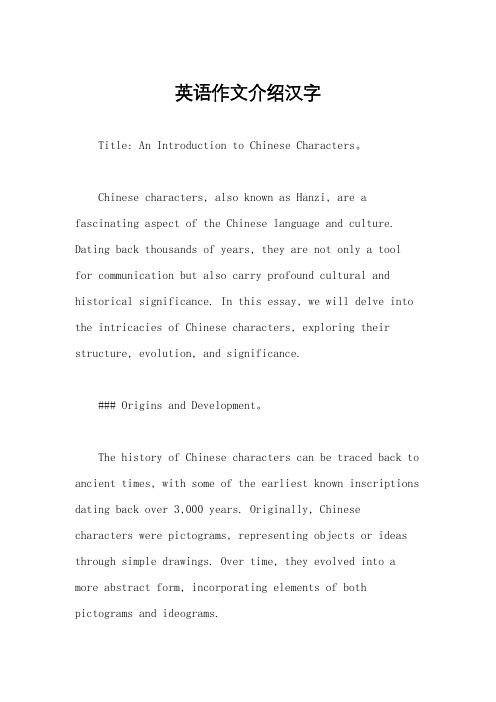
英语作文介绍汉字Title: An Introduction to Chinese Characters。
Chinese characters, also known as Hanzi, are a fascinating aspect of the Chinese language and culture. Dating back thousands of years, they are not only a toolfor communication but also carry profound cultural and historical significance. In this essay, we will delve into the intricacies of Chinese characters, exploring their structure, evolution, and significance.### Origins and Development。
The history of Chinese characters can be traced back to ancient times, with some of the earliest known inscriptions dating back over 3,000 years. Originally, Chinese characters were pictograms, representing objects or ideas through simple drawings. Over time, they evolved into a more abstract form, incorporating elements of both pictograms and ideograms.### Structure and Composition。
中国汉字的英语演讲稿
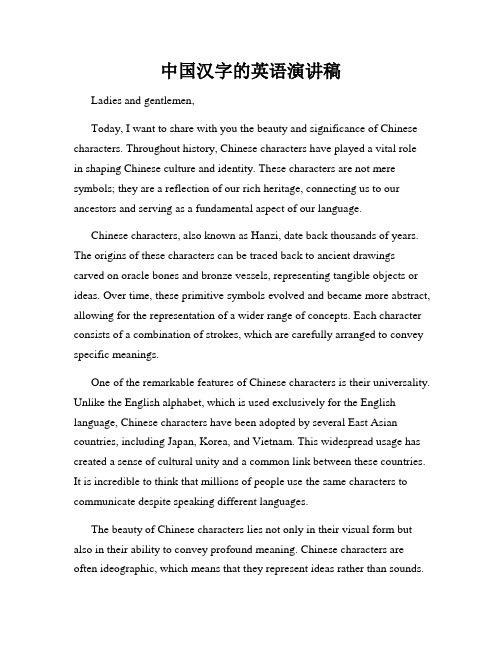
中国汉字的英语演讲稿Ladies and gentlemen,Today, I want to share with you the beauty and significance of Chinese characters. Throughout history, Chinese characters have played a vital rolein shaping Chinese culture and identity. These characters are not mere symbols; they are a reflection of our rich heritage, connecting us to our ancestors and serving as a fundamental aspect of our language.Chinese characters, also known as Hanzi, date back thousands of years. The origins of these characters can be traced back to ancient drawings carved on oracle bones and bronze vessels, representing tangible objects or ideas. Over time, these primitive symbols evolved and became more abstract, allowing for the representation of a wider range of concepts. Each character consists of a combination of strokes, which are carefully arranged to convey specific meanings.One of the remarkable features of Chinese characters is their universality. Unlike the English alphabet, which is used exclusively for the English language, Chinese characters have been adopted by several East Asian countries, including Japan, Korea, and Vietnam. This widespread usage has created a sense of cultural unity and a common link between these countries. It is incredible to think that millions of people use the same characters to communicate despite speaking different languages.The beauty of Chinese characters lies not only in their visual form but also in their ability to convey profound meaning. Chinese characters are often ideographic, which means that they represent ideas rather than sounds.This gives the characters a deeper layer of significance. For example, the character for "love" (爱) combines the symbol for a heart (心) with the symbol for friend (友). This composition visually depicts the essence of love as a friendship of the heart.The art of calligraphy is closely intertwined with Chinese characters, elevating their aesthetic appeal. Calligraphy is not merely handwriting but an expression of artistic flair. Skilled calligraphers carefully craft each stroke, embodying the spirit and mood of the characters they write. The graceful curves and bold lines are a testament to the rich artistic heritage of Chinese culture.Moreover, Chinese characters act as gateways to understanding both ancient and contemporary Chinese literature. Many timeless works of literature, such as the poems of Li Bai and Du Fu, use Chinese characters to evoke profound emotions and paint vivid imagery. Reading these works in their original form, with the beauty and nuances of the characters intact, allows us to fully appreciate the depth of meaning that they convey.In modern times, the importance of Chinese characters has persisted. They are crucial for preserving historical records and inscriptions. Chinese characters are often used in traditional ceremonies, such as weddings and lunar New Year celebrations, where they are showcased on red lanterns and decorative banners. They serve as a reminder of our cultural heritage and provide a sense of continuity in a rapidly changing world.Efforts have been made to promote the understanding and appreciation of Chinese characters overseas. Chinese language programs have been established in educational institutions worldwide, enabling students to learnthe language and understand the characters. Additionally, international events like the Chinese Bridge Competition have provided a platform for foreign learners to showcase their mastery of Chinese characters through speeches and performances.In conclusion, Chinese characters are a representation of our cultural identity, connecting us to the rich heritage of China. Their universality, profound meaning, and artistic beauty make them an invaluable part of our language. The study and appreciation of Chinese characters not only promote cultural understanding but also enrich our understanding of human expression. Let us cherish and embrace the beauty and significance of Chinese characters together. Thank you.女士们,先生们:今天,我想与您分享汉字的美丽和意义。
汉字文化英语演讲稿范文
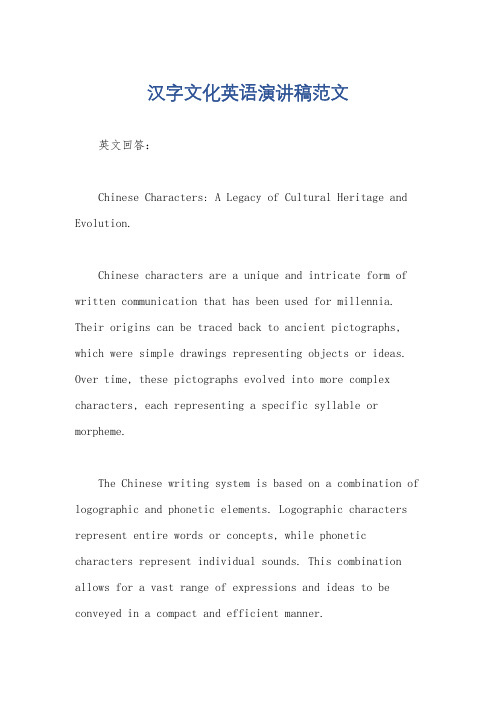
汉字文化英语演讲稿范文英文回答:Chinese Characters: A Legacy of Cultural Heritage and Evolution.Chinese characters are a unique and intricate form of written communication that has been used for millennia. Their origins can be traced back to ancient pictographs, which were simple drawings representing objects or ideas. Over time, these pictographs evolved into more complex characters, each representing a specific syllable or morpheme.The Chinese writing system is based on a combination of logographic and phonetic elements. Logographic characters represent entire words or concepts, while phonetic characters represent individual sounds. This combination allows for a vast range of expressions and ideas to be conveyed in a compact and efficient manner.Chinese characters have played a pivotal role in the development of Chinese culture and civilization. They have been used to record history, literature, philosophy, and scientific knowledge. The study of Chinese characters is an essential part of Chinese education, and the ability to read and write fluently is highly valued.In the modern world, Chinese characters continue to be an important part of Chinese society. They are used in official documents, newspapers, and everyday communication. The advent of digital technology has led to the widespread use of Chinese characters in electronic media, including computers, smartphones, and social media platforms.While the Chinese writing system can be challenging for non-native speakers to learn, it is also a testament to the enduring legacy and vitality of Chinese culture. Chinese characters are not simply a means of communication; they are also a reflection of the rich history, philosophy, and values of the Chinese people.中文回答:汉字,文化传承和演变的瑰宝。
中国汉字英语演讲稿范文
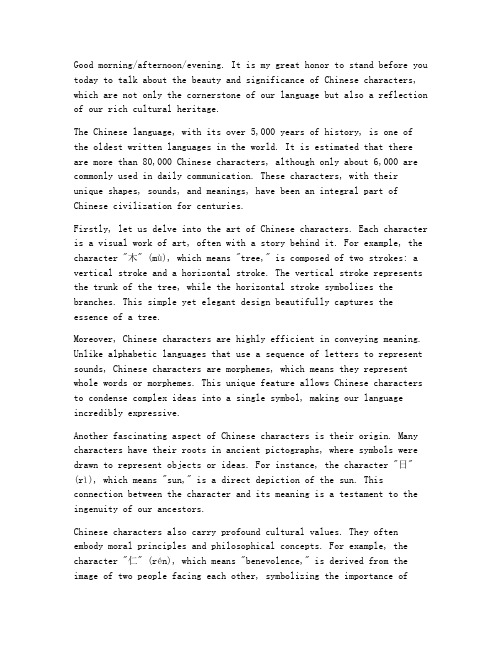
Good morning/afternoon/evening. It is my great honor to stand before you today to talk about the beauty and significance of Chinese characters, which are not only the cornerstone of our language but also a reflection of our rich cultural heritage.The Chinese language, with its over 5,000 years of history, is one of the oldest written languages in the world. It is estimated that there are more than 80,000 Chinese characters, although only about 6,000 are commonly used in daily communication. These characters, with their unique shapes, sounds, and meanings, have been an integral part of Chinese civilization for centuries.Firstly, let us delve into the art of Chinese characters. Each character is a visual work of art, often with a story behind it. For example, the character "木" (mù), which means "tree," is composed of two strokes: a vertical stroke and a horizontal stroke. The vertical stroke represents the trunk of the tree, while the horizontal stroke symbolizes the branches. This simple yet elegant design beautifully captures the essence of a tree.Moreover, Chinese characters are highly efficient in conveying meaning. Unlike alphabetic languages that use a sequence of letters to represent sounds, Chinese characters are morphemes, which means they represent whole words or morphemes. This unique feature allows Chinese characters to condense complex ideas into a single symbol, making our language incredibly expressive.Another fascinating aspect of Chinese characters is their origin. Many characters have their roots in ancient pictographs, where symbols were drawn to represent objects or ideas. For instance, the character "日"(rì), which means "sun," is a direct depiction of the sun. This connection between the character and its meaning is a testament to the ingenuity of our ancestors.Chinese characters also carry profound cultural values. They often embody moral principles and philosophical concepts. For example, the character "仁" (rén), which means "benevolence," is derived from the image of two people facing each other, symbolizing the importance ofempathy and kindness in our interactions. Similarly, the character "义" (yì), which means "righteousness," is composed of a radical meaning "speech" and a radical meaning "horse," suggesting that speaking the truth and acting with integrity are crucial values.Furthermore, Chinese characters have played a crucial role in the development of Chinese culture. They have been the载体 of our literature, poetry, and philosophy. Great works such as the "Book of Changes" (I Ching), the "Classic of Mountains and Seas" (Shan Hai Jing), and the "Analects of Confucius" have all been preserved in Chinese characters, allowing us to understand and appreciate the wisdom of our ancestors.In the modern world, Chinese characters continue to thrive. With the increasing globalization of Chinese culture, more and more people are interested in learning this beautiful language. However, it is important to note that Chinese characters are not just a means of communication; they are a bridge connecting us to our past and shaping our future.In conclusion, Chinese characters are a treasure trove of our cultural heritage. They are a testament to the ingenuity and creativity of our ancestors, and they continue to enrich our lives today. As we embrace the digital age, it is crucial to preserve and promote the beauty and significance of Chinese characters. Let us cherish this uniquelinguistic gift and pass it on to future generations.Thank you for your attention.[Your Name]。
介绍汉字的英语作文
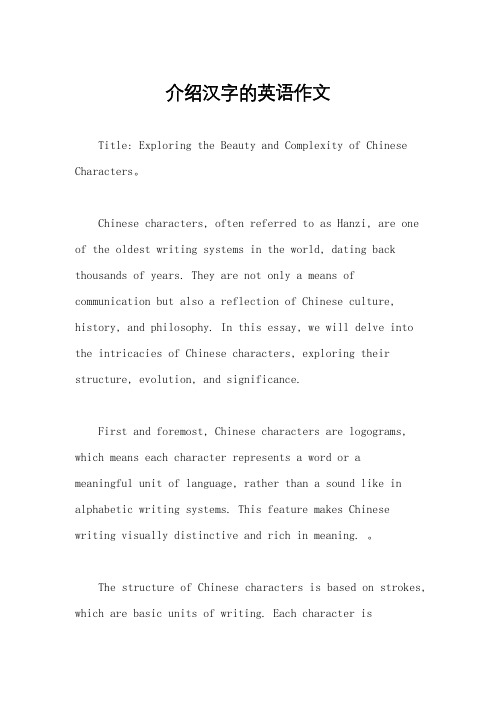
介绍汉字的英语作文Title: Exploring the Beauty and Complexity of Chinese Characters。
Chinese characters, often referred to as Hanzi, are one of the oldest writing systems in the world, dating back thousands of years. They are not only a means of communication but also a reflection of Chinese culture, history, and philosophy. In this essay, we will delve into the intricacies of Chinese characters, exploring their structure, evolution, and significance.First and foremost, Chinese characters are logograms, which means each character represents a word or ameaningful unit of language, rather than a sound like in alphabetic writing systems. This feature makes Chinese writing visually distinctive and rich in meaning. 。
The structure of Chinese characters is based on strokes, which are basic units of writing. Each character iscomposed of one or more strokes arranged in a specific order. Understanding stroke order is crucial for writing Chinese characters correctly and efficiently. There areeight basic strokes in Chinese calligraphy, including horizontal (一), vertical (丨), dot (丶), hook (亅), horizontal hook (乛), vertical hook (乚), left-falling (丿), and right-falling (乀). By combining these strokes in various ways, thousands of characters can be created.Moreover, Chinese characters have undergone significant evolution throughout history. The earliest known Chinese characters date back to the Shang dynasty (1600–1046 BCE) and were inscribed on oracle bones and bronze vessels for divination purposes. Over time, the script evolved into different styles, such as seal script, clerical script, regular script, cursive script, and running script. Each style has its own unique characteristics and aesthetic appeal, reflecting the cultural and artistic preferences of different periods.Furthermore, Chinese characters are deeply intertwined with Chinese culture and philosophy. Many characters arepictographic, meaning they are based on images of real objects. For example, the character for "mountain" (山) resembles three peaks, while the character for "sun" (日) resembles a circle with a dot in the center. Other characters are ideographic, representing abstract concepts or ideas. For instance, the character for "peace" (平) consists of the radical for "roof" (宀) over the radicalfor "one" (一), suggesting the concept of "tranquility under one roof." 。
英语汉字文化讲座作文
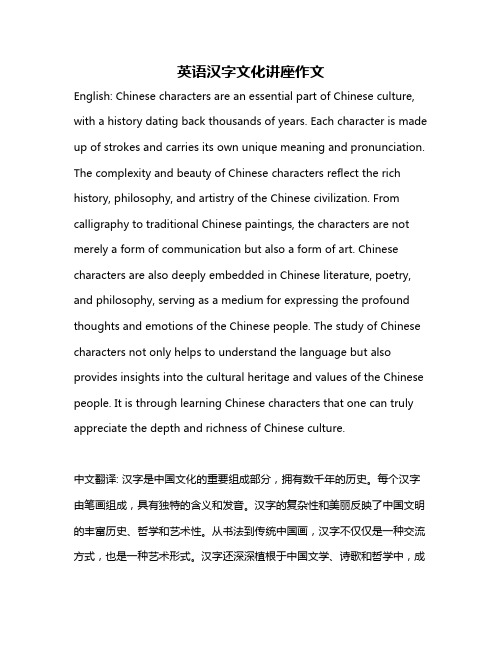
英语汉字文化讲座作文English: Chinese characters are an essential part of Chinese culture, with a history dating back thousands of years. Each character is made up of strokes and carries its own unique meaning and pronunciation. The complexity and beauty of Chinese characters reflect the rich history, philosophy, and artistry of the Chinese civilization. From calligraphy to traditional Chinese paintings, the characters are not merely a form of communication but also a form of art. Chinese characters are also deeply embedded in Chinese literature, poetry, and philosophy, serving as a medium for expressing the profound thoughts and emotions of the Chinese people. The study of Chinese characters not only helps to understand the language but also provides insights into the cultural heritage and values of the Chinese people. It is through learning Chinese characters that one can truly appreciate the depth and richness of Chinese culture.中文翻译: 汉字是中国文化的重要组成部分,拥有数千年的历史。
中国汉字文化英语演讲稿范文
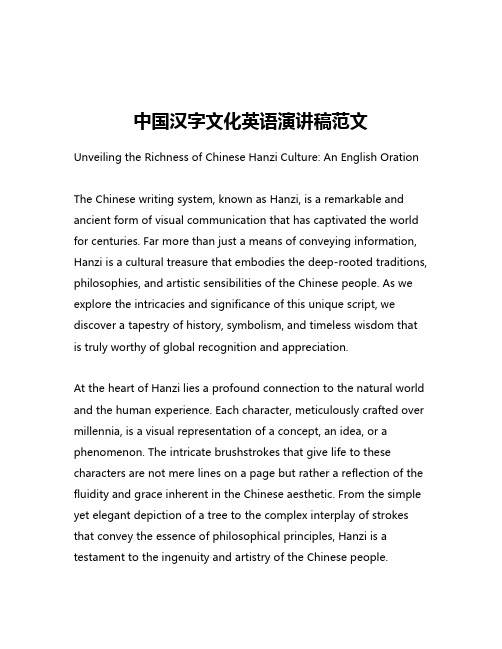
中国汉字文化英语演讲稿范文Unveiling the Richness of Chinese Hanzi Culture: An English OrationThe Chinese writing system, known as Hanzi, is a remarkable and ancient form of visual communication that has captivated the world for centuries. Far more than just a means of conveying information, Hanzi is a cultural treasure that embodies the deep-rooted traditions, philosophies, and artistic sensibilities of the Chinese people. As we explore the intricacies and significance of this unique script, we discover a tapestry of history, symbolism, and timeless wisdom that is truly worthy of global recognition and appreciation.At the heart of Hanzi lies a profound connection to the natural world and the human experience. Each character, meticulously crafted over millennia, is a visual representation of a concept, an idea, or a phenomenon. The intricate brushstrokes that give life to these characters are not mere lines on a page but rather a reflection of the fluidity and grace inherent in the Chinese aesthetic. From the simple yet elegant depiction of a tree to the complex interplay of strokes that convey the essence of philosophical principles, Hanzi is a testament to the ingenuity and artistry of the Chinese people.One of the most striking features of Hanzi is its ability to convey multiple layers of meaning within a single character. Unlike the linear, phonetic-based writing systems of many Western languages, Hanzi characters are ideographic, meaning they represent ideas or concepts rather than solely sounds. This allows for a depth of expression and nuance that is unparalleled, as each character can evoke a range of associations, emotions, and cultural references.Consider the character "心" (xīn), which translates to "heart" in English. This deceptively simple character not only denotes the physical organ but also represents the philosophical and emotional center of the individual. It embodies the essence of human emotions, from love and compassion to courage and determination. Similarly, the character "道" (dào) encompa sses the profound concept of the Tao, the fundamental principle that underlies the natural order of the universe. The richness of these characters, and the wealth of wisdom they encapsulate, is a testament to the profound depth of Chinese thought and culture.Beyond its linguistic and philosophical significance, Hanzi also holds immense artistic value. The calligraphic tradition in China is a revered practice that elevates the written word to the realm of fine art. Master calligraphers, through their skilled manipulation of ink and brush, transform the characters into works of breathtaking beauty and elegance. The fluid movements, the balance of positive andnegative space, and the sheer expressiveness of calligraphic Hanzi are a testament to the deep connection between language, art, and the human spirit.Regrettably, as the world becomes increasingly interconnected, there is a growing risk of cultural homogenization, where the unique and ancient traditions of civilizations like China may be overshadowed by the dominance of global languages and Western cultural influences. It is, therefore, imperative that we recognize the inherent value and significance of Hanzi, and work to preserve and promote this remarkable cultural heritage.Through educational initiatives, cultural exchanges, and a deeper appreciation for the richness of the Chinese language and its associated traditions, we can ensure that the legacy of Hanzi continues to thrive and inspire generations to come. By understanding the depth and complexity of this writing system, we not only gain a greater appreciation for Chinese culture but also expand our own perspectives and enrich our understanding of the human experience.In conclusion, the Chinese Hanzi culture is a testament to the enduring power of language, art, and philosophical thought. As we delve into the intricacies of this remarkable script, we uncover a world of symbolism, wisdom, and beauty that transcends theboundaries of time and geography. By embracing and celebrating the richness of Hanzi, we can cultivate a deeper respect for cultural diversity and foster a global community that values the unique contributions of all civilizations.。
汉字的演变作文200字
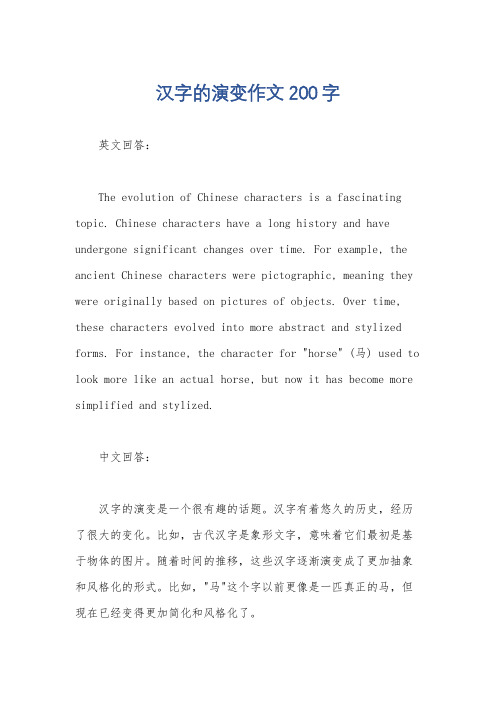
汉字的演变作文200字
英文回答:
The evolution of Chinese characters is a fascinating topic. Chinese characters have a long history and have undergone significant changes over time. For example, the ancient Chinese characters were pictographic, meaning they were originally based on pictures of objects. Over time, these characters evolved into more abstract and stylized forms. For instance, the character for "horse" (马) used to look more like an actual horse, but now it has become more simplified and stylized.
中文回答:
汉字的演变是一个很有趣的话题。
汉字有着悠久的历史,经历了很大的变化。
比如,古代汉字是象形文字,意味着它们最初是基于物体的图片。
随着时间的推移,这些汉字逐渐演变成了更加抽象和风格化的形式。
比如,"马"这个字以前更像是一匹真正的马,但现在已经变得更加简化和风格化了。
英语汉字的故事演讲稿

英语汉字的故事演讲稿英语汉字的故事。
大家好,今天我想和大家分享的是关于英语汉字的故事。
或许很多人都知道,汉字是中国传统的文字,而英语则是世界上使用最广泛的语言之一。
那么,英语和汉字之间究竟有怎样的联系呢?让我们一起来探索一下吧。
首先,我们知道汉字是一种象形文字,它的每一个字都蕴含着丰富的文化内涵和历史故事。
而英语则是一种拼音文字,它的字母构成了单词,单词构成了句子,句子构成了文章。
这两种文字看似截然不同,但事实上,它们之间有着千丝万缕的联系。
其次,让我们来看看一些英语单词的来源。
很多英语单词其实是源自于汉字的。
比如,“ketchup”这个单词就是源自于中国的“茄汁”,而“kung fu”则是源自于中国的“功夫”。
这些单词的来源,反映了英语和汉字之间的文化交流和相互影响。
此外,英语和汉字之间还有着共同的故事。
比如,“禅”字在中国是佛教的一种宗派,而在英语中,“zen”则是指一种心灵上的宁静与平和。
这些共同的故事,展现了不同文化之间的共通之处。
最后,让我们来思考一下,英语汉字的故事给我们带来了什么启示。
它告诉我们,不同的语言和文字之间并不是孤立的存在,它们之间有着千丝万缕的联系和交融。
正是因为这种联系,我们才能够更好地理解和尊重不同的文化,促进不同文化之间的交流和融合。
在今天的世界上,跨文化交流和融合已经成为了一种趋势。
而了解英语汉字的故事,不仅可以帮助我们更好地学习和理解这两种文字,更重要的是,它可以帮助我们更好地理解和尊重不同的文化,促进世界各国之间的友谊和合作。
总而言之,英语汉字的故事告诉我们,不同的文字和语言之间并不是孤立的存在,它们之间有着千丝万缕的联系和交融。
正是因为这种联系,我们才能够更好地促进文化交流和融合,实现世界的和平与发展。
谢谢大家!。
汉字的演变100字左右作文
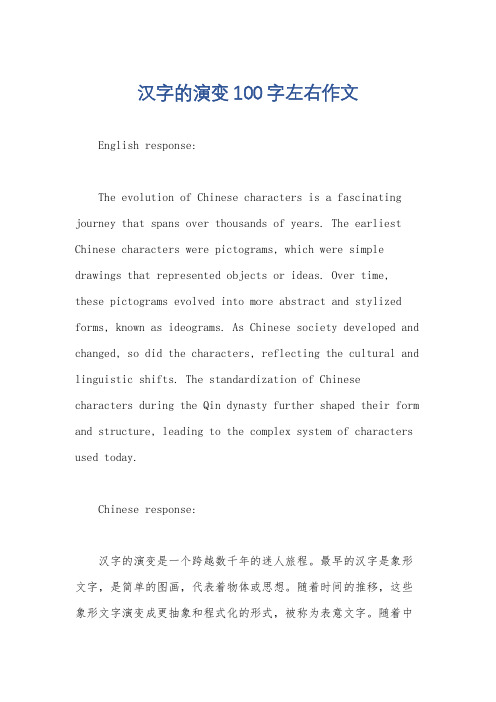
汉字的演变100字左右作文English response:The evolution of Chinese characters is a fascinating journey that spans over thousands of years. The earliest Chinese characters were pictograms, which were simple drawings that represented objects or ideas. Over time, these pictograms evolved into more abstract and stylized forms, known as ideograms. As Chinese society developed and changed, so did the characters, reflecting the cultural and linguistic shifts. The standardization of Chinese characters during the Qin dynasty further shaped their form and structure, leading to the complex system of characters used today.Chinese response:汉字的演变是一个跨越数千年的迷人旅程。
最早的汉字是象形文字,是简单的图画,代表着物体或思想。
随着时间的推移,这些象形文字演变成更抽象和程式化的形式,被称为表意文字。
随着中国社会的发展和变化,汉字也随之演变,反映了文化和语言的变化。
秦朝时期的汉字标准化进一步塑造了它们的形式和结构,形成了今天使用的复杂汉字系统。
英语演讲——书法

Of the four original and major ancient civilizations-China, India, Egypt and Babylon-the Chinese civilization is the only one that has endured. Often, researchers attributed the continuation to the messenger of Chinese culture-the Chinese characters.
草书《洛神赋》
Thank you
楷书刘墉《佛经》
Xing Shu
行书
Xing shu is much more of a free hand type style.Strokes are often simplified.
Xing Shu
行书
This script is as popular as the regular script in scope(范围) and duration, and today most people use this style when they write by hand.
金文
Xiao Zhuan
小篆
Xiao zhuan is a tall,thin script with characters.The characters are highly artistic, with rounded end strokes and symmetrical(对称的) structure.
小篆的笔画首尾匀圆,结构对称,是一种高度美术化 的书体。
Xiao Zhuan
- 1、下载文档前请自行甄别文档内容的完整性,平台不提供额外的编辑、内容补充、找答案等附加服务。
- 2、"仅部分预览"的文档,不可在线预览部分如存在完整性等问题,可反馈申请退款(可完整预览的文档不适用该条件!)。
- 3、如文档侵犯您的权益,请联系客服反馈,我们会尽快为您处理(人工客服工作时间:9:00-18:30)。
Chinese characters are usually round outside and square inside, which is rooted in ancient Chinese beliefs of an orbicular sky and a rectangular earth.
结绳说 八卦说 仓颉造字说
diagram: n. a symbolic and simplified representation
ng Jie created the characters
In legend, there was a figure in remote antiquity named Cang Jie who was an official historian of Huangdi(known as the Yellow Emperor). It was said that he had 4 eyes, and the upper 2 were for watching the sun, the moon and the stars while the lower 2 for watching mountains, rivers, beasts and birds. And it was he, as the legend goes, who had created the Chinese characters according to the shapes of all things.
A
B
C
D
E
F
G
形 image 音 sound 韵
rhyme
意
idea
人
众(眾)
鬼
老
见(見)
夫
荷
望
仆(僕)
Chinese Characters
中 国 汉 字
Producted by Liu Tongxin
The Chinese Character
•The Chinese Character is the oldest, continuous written language in the World. •The inventors of the written language drew pictures to express words or ideas, simple pictures were combined to make more complex thoughts. •The Chinese Character is square-shaped.
inscription: n. a piece of writing inscribed on a stone cursive: a. written with the characters joined
Oracle Bone Inscriptions
divination: n. the ability to say what will happen in the future engrave: v. to cut words or designs on matal, wood, glass etc.
1st 2nd
Bief-introduction
contents
Invention
3rd
Developme nt
Chinese characters were initially meant to be simple pictures use to help people remember things. After a long period of development, it finally became a unique character system that embodies sound, image, idea, and rhyme at the same time. 音,形,意,韵
orbicular: a. globose rectangular: a. having the shape of a rectangle
The invention of the Chinese characters
Keep records by tying knots The Eight Diagrams Cang Jie created the characters
Cang Jie created the characters
So he has the title of “Sage of Charactercreation”, as later generations addressed him. Nevertheless, it is improbable for any single person to create a complicated character system at one time. The characters is actually developed by many people gradually in the long process of invention, accumulation, and evolution.
Cursive Script
Cursive Script includes Zhangcao, Jincao and Kuangcao. Kuangcao was created in the Tang dynasty, and very difficult to identify, turned into a pure art. There are few practical value.
The development of Chinese characters
Oracle Bone Inscription 甲骨文 Bronze Inscription 金文 Seal Script 篆书 Official Script 隶书 Regular Script 楷书 Cursive Script 草书 Running script 行书
( ( ( ( ( ( (
)1.Seal Script )2.Bronze Inscription )3.Regular Script )4.Running script )5.Cursive Script )6.Official Script )7.Oracle Bone Inscription 1.C 2.B 3.E 4.G 5.F 6.D 7.A
Bronze Inscriptions
书法是一项十分精细的活动。要想把字写好,须得全神贯注,凝神静气,仔细观察字的结
构,并要脑、眼、手相应,准确控制运笔的轻重缓急。
Seal Script
Seal Script can also be called as “Script of Qin”,
including “Dazhuan”and “Xiaozhuan”.
stage.
Regular script
It was the most popular in Tang Dynasty.
In this stage, there were many famous
calligraphers.
Running script
Running Script emerged at the end of the Eastern Han period. it is a kind of form between regular script and cursive script. It has high artistry and practicality.
Official(clerical) script
It originated from Qin Dynasty and fully
developed in Han Dynasty. The emergence of
official script is the second big reform of text, making Chinese calligraphy art enter a new
